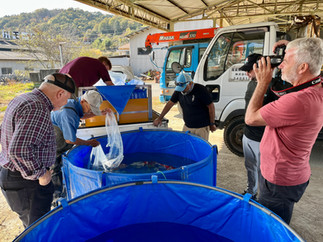Japan Autumn 2023, Blog - 8
- anthonygrey19
- Nov 19, 2023
- 6 min read
Harvest Day
When you visit Japan in search of Nishikgoi koi and visit koi breeders and their farms a highlight of your trip is to witness a mud pond harvest, but to actually help in a harvest and help with the harvested koi is such a bonus and becomes a super special day for a koi hobbyist!!
Our special day was to help Mike Snaden of Yume Koi Japan harvest a large mud pond set in a very picturesque landscape, which housed the mud pond challenge koi an event setup earlier in the spring where participants purchased from a draw of special Tosai koi from a selection of breeders. With all koi being placed into the mud pond to grow over the summer until harvested.
We were lucky enough to help in last year’s harvest which was an absolute privilege, but this year we were to be more involved with the actual harvest itself.
In brief, for our non-koi friends a mud pond is used to grow koi throughout the warm summer months in a natural environment. In spring they are released into the warming water and before the colder weather returns in the autumn the koi are harvested collected and returned to the farm for selection. It’s a great natural way to raise koi throughout the summer months as the water is very warm and with correct feeding regime the koi grow very fast. Of course, growing koi this way comes with many hazards such as predators, but the results are normally worth it,
Before the big day there were still some preparation work to do, and this started the day before. Firstly, preparing the kei trucks such as the zippy transport vats on the back, oxygen, nets etc, etc. Checking the concrete holding pond where the koi would be held, setting up two blue vats to initially receive the koi after harvesting, measuring bowls, documentation, etc, then we were off to the mud pond itself to see if the water levels were correct. So, with the harvest date set the timing has to be critical regarding the draining of the water this is achieved by pulling a series of standpipe plugs from the top, down to the base to allow the water to drain to a certain level in a controlled manner. This particular pond takes approximately a week to drop to a level low enough at one end to harvest the koi safely, but enough water left for the koi to swim with enough oxygen levels and feel safe so predators cannot gain access to the koi during that final night before the mornings harvest. On inspection the pond was a little too high, so it was decided to pull one more plug later that evening to reduce the water level further.
Another reason why the timing of draining the water is critical is a crane had been hired for the morning of the harvest, ‘yes a crane’ as mud ponds often have steep banks. The koi are placed in crane bowls and hoisted from the water up to the transport tank on the back of the Kei truck! The pictures explain more.
Finally, the morning came, and it was an early start a quick 7-Eleven breakfast, coffee and with some last-minute details completed we were off. It’s about a 50-minute drive to the mud pond hence the early start. We were also blessed with a lovely sunny warm morning which made for an ideal day for harvesting.
We were also joined by Hassei Takigawa and Senzo Madokoro San (Such a character) who also had some of the equipment to complete the harvest. In total there were three Kei Trucks with equipment which included two transport tanks and nets, etc. The holding transport tanks with fresh water have a certain amount of oxygen going into them which is critical, too much and the koi get too lively!
I have to say we were all fairly buzzing with anticipation and from a personal point of view as Anthony and I had koi residing in this mud pond so the anticipation of seeing them was high. Many of our koi friends hopefully reading this blog also had koi in this mud pond which I know will be eagerly wating back home for updates and pictures of their koi, once the koi have settled in the holding pond.
With the Kei trucks in position the crane arrived and positioned itself ready. Mike, Hassei and Madokoro San prepared the equipment, harvesting net, etc, and set everything up ready. With all the hobbyists prepared and, in their waders, (Chesties), it was not long before the net was being taken around the perimeter of the remaining water by Anthony and Chip. This encloses around the koi bringing them together. The mud was extremely sticky and hard work which made viewing very funny with the boys getting stuck, Anthony started to get the technique and continued on helped by Hassei as it was important to get round the koi ASAP to enclose the net to stop any escapees.
Once this operation was performed the final part being the encircling net tightened and drawn to the edge leaving only a small surface area which held the koi to be harvested. A couple of koi jumped over the encircling net, so the netting process had to be performed again once all the first koi had been collected. The next process involved handpicking the koi into a round bowl, then ten koi at a time were placed into the crane bowls. This was performed by Madokoro San, Anthony, Chip and Dan. With Mike and Hassei up at the kei trucks unloading the koi into the tanks. This process was performed numerous times until all koi were counted for. The pictures explain this much better!
It was amazing to see the baskets hoisted up in the air knowing what was inside, but the process was seamless especially watching the crane driver lowering the crane bowl onto the back of the Kei truck ready for Mike and Hassei to lift the koi from the crane bowls into the transport vats. I think there was about 14 or so crane bowls of koi hoisted out of the mud up to the waiting Mike and Hassei.
There were other jobs performed such as a counter for the number koi harvested and me being the chief photographer (in my mind the most important job of the day!!). It was good to see everyone working so hard and I know Anthony was in his element and could have gone again!!
Harvesting completed, we all had a well-deserved drink and snack then off we went as it was important to get the koi to the concrete holding pond for processing which involved checking over all the koi, IDing and measuring the koi then placing into a concrete holding pond to settle.
Arriving at the concrete pond where the koi are to housed to settle, we were all issued jobs to get the production line going with my job this year was to help bag the koi two at a time if possible out of the transport tanks which was a bit hard on the old back and knees, then handing them over to Dan who was placing them into the two blue vats. Once all the koi had been placed into the vats the process of identification and measurement could take place. Anthony’s role was measuring the koi, placing them into a bowl for videoing and then into the concrete pond, Chip was the video man with David (one of the previous challenge winners) carrying the koi from the blue vats to Anthony for measuring and placing into the concrete pond. Mark & Ritta on documentation with Mike selecting the koi for being bagged but more importantly selecting contenders to be put forward for the final selection of winners. I also then moved onto helping to identify the koi, which was difficult at times as so many had changed.
This process had taken just over 3 hours which was very tiring but enjoyable. It was good to see how well the koi had performed and the good condition they were in, of course there were one or two mud pond bits and bobs on them but nothing out the norm. It was also good to see how well the actual mud pond had performed, which I know Mike San was very pleased based on last year’s performance.
All in all, it had been a fantastic day and a privilege to help, of course the next thing after freshening up was to go out for a meal and a couple of celebratory beers!!
Also, we now have a website which is solely dedicated to our travels in Japan. Please visit www.japanguiding.com to read all our articles about the locations we have visited in Japan.
Please respect our website copyright regarding our content and pictures.









































































































































Comments